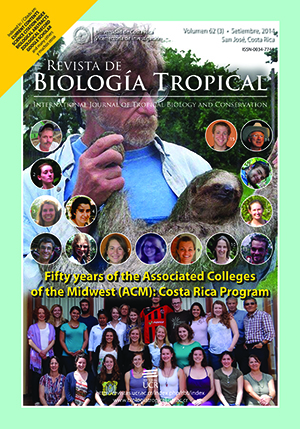Abstract
Cacao (Theobroma cacao) is an important cash crop in tropical climates such as that of Latin America. Over the past several decades, the infection of cultivated cacao by Moniliophthora roreri, known commonly as "monilia", has significantly hindered cacao production in Latin America. Studies have proposed the use of Trichoderma sp. fungi in biocontrol treatments to prevent and reduce monilia infection, yet tests of Trichoderma-containing spray treatments on cacao agroforests have produced mixed results. Researchers and agricultural workers have suggested that addition of soil, fly ash, or other carbon sources to a Trichoderma spray may improve its efficacy in fighting monilia. To test these suggestions, we designed a series of spray mixtures including Trichoderma cultures, soil, and all necessary controls. We applied the spray mixtures to 80 cacao trees (20 trees for each of four resistant-selected clones to monilia) at the FINMAC organic cacao plantation in Pueblo Nuevo de Guacimo, Limón Province, in northeastern Costa Rica in March-April 2013. Five treatments were applied (control, water, water plus sterilized soil, water plus Trichoderma, and water plus sterilized soil plus Trichoderma). Each treatment was applied to four trees of each clone. We monitored the incidence of monilia infection under each spray treatment over the course of 35d. We found that spraying entire cacao trees two times with a mixture containing Trichoderma and sterilized soil significantly reduced the incidence of monilia infection by 11% (p<0.05) in only 35d, as compared to the control. This reduction in loss of cacao pods translates into an increase of plantation mean productivity of 1 500kg dried beans/ha by 198kg/ha up to 1 698kg/ha or by a total increase over the whole 110ha plantation by 21 780kg. We propose that using such an antifungal spray over the whole course of a crop cycle (120 days) would decrease infection incidence even more. Application of this fungal control measure has the potential of revitalizing the production of cacao in the region.
John Seng1, Geovanny Herrera2, Christopher Vaughan3,4 and Michael McCoy Colton3,5
1Grinnell College, Grinnell, IA, USA; sengjohn@grinnell.edu
2Milwaukee Public Museum, Milwaukee, WI 53233-1478, USA
3Associated Colleges of the Midwest, San Pedro de Montes de Oca, Costa Rica
4cvaughan@acm.edu
5mmccoycolton@yahoo.com
##plugins.facebook.comentarios##

This work is licensed under a Creative Commons Attribution 4.0 International License.
Copyright (c) 2014 Revista de Biología Tropical






